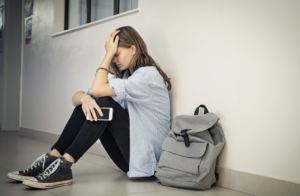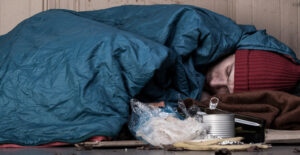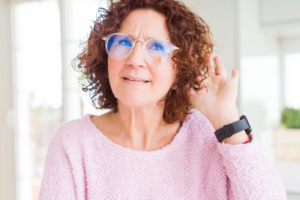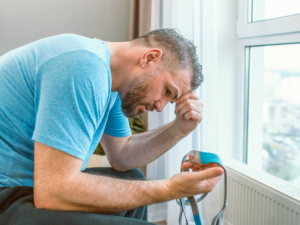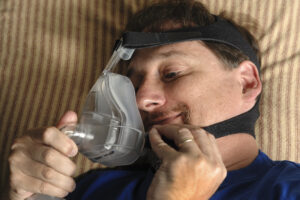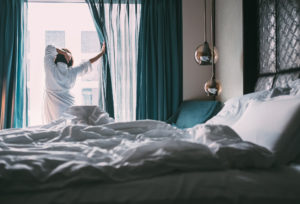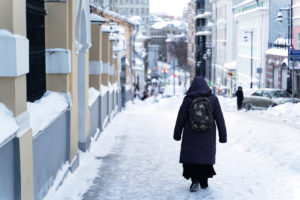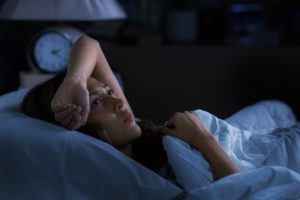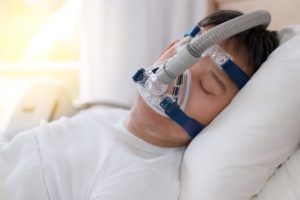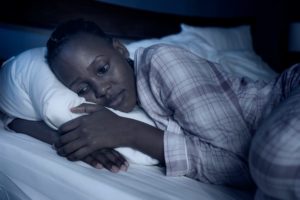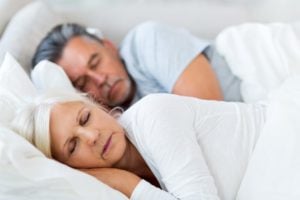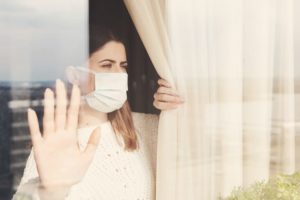The Structural Inequality of Sleep: An Interview With Dr. Dayna Johnson
| Key points |
|---|
|
Introduction

This is our second interview in Sleep Foundation’s Inequality Series, a collection of interviews and articles that highlight the contours and effects of sleep inequality. In this conversation, we talk with Dr. Dayna Johnson, Assistant Professor in the Department of Epidemiology at the Rollins School of Public Health at Emory University. She specializes in exploring the structural, social, and environmental causes of sleep health disparities.
In the Q+A below, Dr. Johnson makes the case that sleep disparities are the result of an interconnected set of inequities that prevent people of color in the United States from having opportunities for quality sleep. These issues stem from racially and culturally stratified neighborhoods; policies that keep urban areas poorer and more polluted than more affluent suburbs; the stressors of encounters with institutional and individual racism; and the lack of serious public messaging around healthy sleep habits.
Sleep Foundation: Thanks for spending some time with us on this topic. Let’s begin by talking about your background. What led you into the field of sleep scholarship?
Dayna Johnson: My interest in science before I discovered sleep, was in health disparities. I was very interested in understanding some of the reasons why certain groups were more likely to have certain conditions and have more severe disease for specific conditions than other groups. When I started my Ph.D. program, I knew I would focus on the neighborhood environment. Which, at the time — and still currently — was one of the main hypothesized contributors to cardiovascular disease.
Also, I was studying under the expert on neighborhoods and cardiovascular disease: Ana Diez Roux. As you can imagine, there were lots of people that were interested in the topic; that’s why we were all there.
I wanted to do something slightly different. I heard a talk by Gary Gibbons — who is now the head of NHLBI [National Heart, Lung, and Blood Institute] — where he mentioned sleep as a risk factor for stroke. It resonated with me and made me think a little bit more about sleep.
I did some research, and of course research showed that sleep was related to different cardiovascular outcomes. I thought, well, perhaps this is the pathway that’s connecting neighborhoods and cardiovascular disease. At the time there was no work really understanding that pathway.
I was at the University of Michigan and they had a great sleep medicine program. I connected with people there and I started learning sleep. I did my Ph.D. focused on sleep, I studied psycho-social stressors and neighborhoods, different neighborhood characteristics and how that contributed to different sleep outcomes. Then I did a postdoc at Harvard to really refine my sleep skills. That’s where I really learned about how to measure sleep and analyze sleep variables from different sleep studies.
Sleep Foundation: So you began your doctoral work with this interest in neighborhood disparities. And I’m sure that also forces you to grapple with issues of socioeconomic status, one’s education level, race — all different sorts of factors, right?
Dayna Johnson: For some of it, yes. There’s a framework called intersectionality that, in the epidemiology world, encourages researchers to consider the different intersections of race, gender, socioeconomic status on health.
The intersections of race and socioeconomic status are complex. What we’re usually taught — and what we expect — is that as your socioeconomic status increases, your health is better. The more you earn and the more education you have, the better your access to healthcare, and therefore you should have better health.
We did not see that for African Americans, in particular. We actually see African Americans that are higher on the socioeconomic gradient, they actually have worse sleep than those on the lower socioeconomic gradient. We are not seeing education and income as protective for their sleep health.
“We actually see African Americans that are higher on the socioeconomic gradient, they actually have worse sleep than those on the lower socioeconomic gradient. We are not seeing education and income as protective for their sleep health.”
I’m sure you’re wondering, why would that be? When we’re talking about race, we’re really considering that as a social construct. Which means it is a proxy for social experiences.
When we’re using race in these studies, what we’re really trying to get at is racism. We’re really talking about the experiences that you have because of your skin color. When we think about the reason why, in particular Black adults have worse sleep is because of these experiences of racism.
The stressors are different. At this level you’re more likely to be the minority at your job, which opens you up to more experiences of discrimination or microaggressions. You’re also more likely to be a minority in your neighborhood. There could be other factors, too, such as feeling like you have to work harder, and imposter syndrome tends to be common. In fact, that’s another work-related stress: you’re working harder, you’re trying to ensure that people understand that you’re there because of your skill and talent, and not your race. There’s all these other factors that come into play that are potentially contributing to why we see worse health among this population.
There are instances where we see regardless of race that individuals, Black, white, Hispanic, that live in lower income areas, have poorer health than those in more affluent areas. There are no observed racial disparities in these lower income neighborhoods. In some studies you see white individuals are doing worse than Black individuals when living in similar lower income areas. That really drives the point that there is something happening in the environment as opposed to these other stressors that I’m mentioning.
When we look at higher income neighborhoods we see a sleep disparity. We see that Black individuals have worse sleep. One of ways we try to understand this is through the minority stress model. We’re really seeing that minorities have unique stressors, or they experience unique stressors, over and beyond the stressors that everybody else experiences. We all may have some financial stress, you may have some emotional stress, but If you are a minority, you have other stressors that are additive as well as those other stressors that people have.
Sleep Foundation: In addition to some of the social stratification or economic stratification you mention, what are some of the issues you see people of color facing when it comes to their sleep? How would you describe the contours of the problem?
Dayna Johnson: The root causes of sleep and health disparities overall is racism. There are a number of papers and publications that are supporting racism and discrimination as the root causes of inequalities.
Let me give you an example, if we go back in time and we think about segregation. People were separated based on their race. You were segregated into different neighborhoods. We know each of those neighborhoods were different in terms of education, and all of the things that are fundamental in terms of where you are in life. The quality of schools were different. The access to healthy foods was different, and it’s still different today. We know that inner city schools, large public school systems, have less resources and a larger teacher student ratio than smaller school systems. They also tend to be in urban areas where racial minorities are more likely to live.
Health care access is more limited; transportation is different. And then if you add in things like redlining and housing covenants, which denied minorities from having home ownership in affluent areas, they were restricted to more disadvantaged areas, we have the historical basis of residential segregation. Even until today, African Americans are more likely to live in areas below their income level.
If you think about those living in these areas where they were paying a higher interest rate on the mortgages, and then the price of items in those areas were a lot more. That contributes to the current wealth gap.
If we’re thinking about these root causes, this was all the result of racism. There are different ways that we’re studying that today, looking at structural racism and structural discrimination. If we think about other racial minority groups like Hispanic or Latinx populations, they are affected by acculturation stress: being in a new area, having a language barrier or adapting to a new language and having people perceive your language as different. That tends to come with different stressors. We know that contributes to poor sleep in Latinx populations.
If we think about other racial minority groups like Hispanic or Latinx populations, they tend to be more affected by acculturation stress: being in a new area, having a language barrier or adapting to a new language and having people perceive your language as different. That tends to come with different stressors. We know that contributes to poor sleep in Latinx populations.
If we think about Asian populations, they’re affected by the model minority model. They’re considered [to be] this group that should excel in all these areas, and that adds this additional stress that contributes to poor sleep in that population.
There are some other factors that come into play, particularly for African Americans. The examples I gave really lent itself to the reason why we see shorter sleep duration and poorer sleep quality in these populations. But we also see more severe sleep apnea and a greater severity of sleep apnea in these populations, and that’s for a different reason. For example, in African American and Latinx populations there tends to be higher rates of obesity, which is associated with sleep apnea, and also may be the result of neighborhood structures (lack of access to healthy foods and physical activity).
If you are in an area that lacks sidewalks, if you do not have access to healthy foods, if you are a shift worker or if you work rotating shifts, your circadian rhythms are misaligned and so your eating patterns are off. That contributes to weight gain. Short sleep duration contributes to weight gain. Our hormone secretion is altered and so on. We know obesity is one of the major risk factors for sleep apnea. The other piece of this that really relates to sleep inequities is that minorities are less likely to be screened for a sleep disorder although they’re more likely to have a sleep disorder.
If you go see your physician and you have that 10-15 minutes, what we’re seeing is they’re not being asked about their sleep and so they don’t get referred to the sleep clinic for proper screening.
Additionally, there are cultural differences in their presentation. As a sleep epidemiologist, I know snoring is a risk factor of sleep apnea. But, why would the general population know that if you have never been told that, particularly if this has never come up in a visit? I hear people regularly say, “Oh, I had some really good sleep last night because I was snoring.” That probably doesn’t mean you got really good sleep. You probably had more interruptions in your sleep cycle.
In many cases, the individuals are not feeling better or rested during the day, but they are using snoring as a sign of sleeping well.
Sleep Foundation: To the degree that there are recommendations for solving a problem like this, is it a policy prescription? Is it a messaging solution? Is it more of an economic one?
There are lots of campaigns about knowing your numbers — hypertension, cholesterol — it was a huge campaign; the public health world rallied together and pushed people to know their numbers. Do we have any sleep campaigns? I’ve never seen one. I will say that sleep is one of the goals for Healthy People 2020 and also Healthy People 2030.
There is starting to be more national attention, but we have no promotion of this. In school you learn about the food pyramid — you learn about how much protein, how many carbs. You have recess and you learn about the importance of physical activity. But where across that education spectrum do you learn about healthy sleep duration? I think there should be a campaign of healthy sleep awareness.
“At the individual level, we need to do a better job with promoting healthy sleep practices. We need to make sure people understand how much sleep they should get, make sure they understand the symptoms of sleep apnea, the symptoms of insomnia, just like we understand the symptoms for stroke.”
As we move through these different levels, we can think about the household environment. We need to make sure that people are sheltered at the bare minimum, and that they are in homes that are intentionally designed to promote sleep. People should be able to control their temperature in their apartment. Thermal comfort is absolutely required for healthy sleep. So is having proper ventilation.
At the neighborhood level, we need to reduce air pollution. Dense intersections promote more traffic, and that promotes black carbon, which is a type of air pollution. Those particles get in our airway and they obstruct our breathing and that contributes to sleep apnea. We can do things to reduce driving and reduce air pollution. We can also hold manufacturing plants responsible for the pollutants that they are emitting into the air.
All of these things are really targeted at addressing inequities, particularly because it’s racial minorities and immigrants that live in these areas that are most affected.
At the structural level, it means addressing things like structural racism, structural discrimination. There are people who study interventions to address structural racism. One example would be to increase the minimum wage. Make it an actual livable wage. If you’re making a minimum wage and you have a family, you probably need multiple jobs. That would interrupt your sleep. You also may not be home to implement a consistent bedtime with your children. They are setting a trajectory of not having a bedtime routine, and that will contribute to worse sleep in adulthood.
Sleep Foundation: I want to ask you about your paper from last year about the impact of the coronavirus on these disparities. Broadly speaking, how did you see the virus and the economic impacts of that virus impact neighborhoods and communities of color disproportionately? What were some of the themes you were trying to highlight with that paper?
Dayna Johnson: What I saw most was a lack of testing. Once people were hospitalized, we saw more deaths among racial minorities. There is current research aimed at understanding what was contributing to these disparities.
I believe in thinking about the structural reasons for why this happened. Racial minorities are more likely to be essential workers. They’re the ones in the grocery stores, they’re the ones on the front lines that are more vulnerable to getting the virus. Additionally, they were less likely to have paid time off or jobs where they could work from home.
Not everyone has the privilege [to work from home] so you are forced to make this decision of working to feed your family and be vulnerable to the consequences.
We also discussed the added stress of racism at that time. This was right when [the murder of] George Floyd happened and then the murder of Breonna Taylor. Not only are you scared that you may be infected with COVID-19, but also have anxiety around police brutality.
You are concerned about your father, your brother, your husband being pulled over. These experiences of vicarious discrimination, where you are seeing something happen to someone else and you have that fear it could happen to you or a loved one, also can affect sleep, and health.
“The combination of the pandemic plus these stressors are increasing anxiety and rumination, and disproportionately affecting minorities when they're trying to sleep at night. All of these things are fighting something that should be simple: being able to sleep.”
Sleep Foundation: Earlier this year Sleep Foundation held a roundtable conversation with several sleep experts. And they mentioned that the pandemic meant many people had more time on their hands and more opportunities to sleep, but they didn’t take advantage of that. Perhaps they slept a bit more but the sleep was fragmented or they were able to go to bed a little bit later and then sleep in a little bit later. What I hear you saying, though, is that communities of color don’t have that opportunity.
Dayna Johnson: Right, they don’t. That data is still coming in. There are a number of studies that happened over this time so we’ll be able to see. Like you said, overall we know that people did sleep longer but the question is, who are those people and do we see an improvement in sleep quality or more fragmented sleep? I’m very curious to see that data.
Sleep Foundation: Thanks so much for your time. We’ll give you the final word. Is there anything you’d like to add?
Dayna Johnson: In some of these conversations [about sleep inequality] people like to focus on the individual. I try to get people to expand beyond that. Some individual decisions are based on the context in which a person lives. In general, I like to think that people are not making intentional decisions because they want poor sleep – there’s typically some reason, so understanding the barriers to prohibiting healthy sleep including structural barriers, is really the key to moving towards change.


